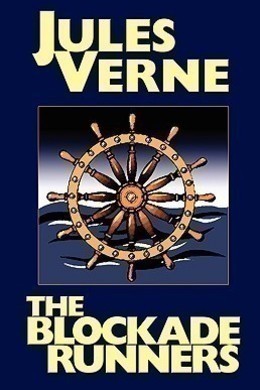
-
EPUB 105 KB
-
Kindle 133 KB
-
Support epubBooks by making a small $2.99 PayPal donation purchase.
Description
The year is 1862 and the United States is engaged in a deadly civil war. President Lincoln has ordered the navy to blockade all Southern seaports. Neutral nations, like England, were told not to try and break through the blockade. This story by the classic author, Jules Verne relives the adventures of one English ship, the Dolphin, and its attempt to “_run the blockade_” into Charleston, South Carolina. Join Captain James Playfair as he makes plans for the voyage and how he discovers something unusual about his newest crew member.
71 pages with a reading time of ~1.25 hours (17857 words), and first published in 1865. This DRM-Free edition published by epubBooks, 2014.
Community Reviews
There are currently no other reviews for this book.
Excerpt
The Clyde was the first river whose waters were lashed into foam by a steam-boat. It was in 1812 when the steamer called the Comet ran between Glasgow and Greenock, at the speed of six miles an hour. Since that time more than a million of steamers or packet-boats have plied this Scotch river, and the inhabitants of Glasgow must be as familiar as any people with the wonders of steam navigation. However, on the 3rd of December, 1862, an immense crowd, composed of shipowners, merchants, manufacturers, workmen, sailors, women, and children, thronged the muddy streets of Glasgow, all going in the direction of Kelvin Dock, the large shipbuilding premises belonging to Messrs. Tod & MacGregor. This last name especially proves that the descendants of the famous Highlanders have become manufacturers, and that they have made workmen of all the vassals of the old clan chieftains. Kelvin Dock is situated a few minutes’ walk from the town, on the right bank of the Clyde. Soon the immense timber-yards were thronged with spectators; not a part of the quay, not a wall of the wharf, not a factory roof showed an unoccupied place; the river itself was covered with craft of all descriptions, and the heights of Govan, on the left bank, swarmed with spectators. There was, however, nothing extraordinary in the event about to take place; it was nothing but the launching of a ship, and this was an everyday affair with the people of Glasgow. Had the Dolphin, then–for that was the name of the ship built by Messrs. Tod & MacGregor–some special peculiarity? To tell the truth, it had none. It was a large ship, about 1,500 tons, in which everything combined to obtain superior speed. Her engines, of 500 horse-power, were from the workshops of Lancefield Forge; they worked two screws, one on either side the stern-post, completely independent of each other. As for the depth of water the Dolphin would draw, it must be very inconsiderable; connoisseurs were not deceived, and they concluded rightly that this ship was destined for shallow straits. But all these particulars could not in any way justify the eagerness of the people: taken altogether, the Dolphin was nothing more or less than an ordinary ship. Would her launching present some mechanical difficulty to be overcome? Not any more than usual. The Clyde had received many a ship of heavier tonnage, and the launching of the Dolphin would take place in the usual manner. In fact, when the water was calm, the moment the ebb-tide set in, the workmen began to operate. Their mallets kept perfect time falling on the wedges meant to raise the ship’s keel: soon a shudder ran through the whole of her massive structure; although she had only been slightly raised, one could see that she shook, and then gradually began to glide down the well greased wedges, and in a few moments she plunged into the Clyde. Her stern struck the muddy bed of the river, then she raised herself on the top of a gigantic wave, and, carried forward by her start, would have been dashed against the quay of the Govan timber-yards, if her anchors had not restrained her. The launch had been perfectly successful, the Dolphin swayed quietly on the waters of the Clyde, all the spectators clapped their hands when she took possession of her natural element, and loud hurrahs arose from either bank. But wherefore these cries and this applause? Undoubtedly the most eager of the spectators would have been at a loss to explain the reason of his enthusiasm. What was the cause, then, of the lively interest excited by this ship? Simply the mystery which shrouded her destination; it was not known to what kind of commerce she was to be appropriated, and in questioning different groups the diversity of opinion on this important subject was indeed astonishing. However, the best informed, at least those who pretended to be so, agreed in saying that the steamer was going to take part in the terrible war which was then ravaging the United States of America, but more than this they did not know, and whether the Dolphin was a privateer, a transport ship, or an addition to the Federal marine was what no one could tell. “Hurrah!” cried one, affirming that the Dolphin had been built for the Southern States. “Hip! hip! hip!” cried another, swearing that never had a faster boat crossed to the American coasts. Thus its destination was unknown, and in order to obtain any reliable information one must be an intimate friend, or, at any rate, an acquaintance of Vincent Playfair & Co., of Glasgow.
